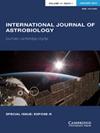Astrophysical existential threats: a comparative analysis
IF 1
4区 物理与天体物理
Q3 ASTRONOMY & ASTROPHYSICS
引用次数: 0
Abstract
Using a simple, coarse-grained Poisson process model, we calculate – for seven types of astrophysical catastrophe – both their individual and combined threat to complex lifeforms (extraterrestrial intelligences (ETIs)) throughout the Milky Way Galaxy. In terms of cumulative effects, we calculate that ETIs are likely to be astrophysically driven extinct on timescales of roughly once every 100 million years. In terms of comparative effects, large bolide impactors represent the most significant type of astrophysical contribution to the galaxy-wide debilitation of hypothesized ETI civilizations. Nonetheless, we conclude that astrophysical existential threats – whether taken singly or in combination – are likely insufficient, alone, to explain the Fermi Paradox. Astrophysical catastrophes, while both deadly and ubiquitous, do not appear to be frequent enough to wipe out every species in the Galaxy before they can attain or utilize spacefaring status.天体物理存在的威胁:比较分析
使用一个简单的粗粒度泊松过程模型,我们计算了七种类型的天体物理灾难,包括它们对整个银河系复杂生命形式(地外智能(ETI))的单独和组合威胁。就累积效应而言,我们计算出ETI很可能在大约每1亿年一次的时间尺度上被天体物理驱动灭绝。就比较效应而言,大型玻利维亚撞击物代表了对假设的ETI文明在银河系范围内衰弱的最重要的天体物理学贡献。尽管如此,我们得出的结论是,天体物理学的生存威胁——无论是单独还是组合——都可能不足以单独解释费米悖论。虽然天体物理灾难既致命又普遍,但在银河系中的每一个物种获得或利用太空地位之前,它们似乎还不足以灭绝。
本文章由计算机程序翻译,如有差异,请以英文原文为准。
求助全文
约1分钟内获得全文
求助全文
来源期刊

International Journal of Astrobiology
地学天文-地球科学综合
CiteScore
3.70
自引率
11.80%
发文量
45
审稿时长
>12 weeks
期刊介绍:
International Journal of Astrobiology is the peer-reviewed forum for practitioners in this exciting interdisciplinary field. Coverage includes cosmic prebiotic chemistry, planetary evolution, the search for planetary systems and habitable zones, extremophile biology and experimental simulation of extraterrestrial environments, Mars as an abode of life, life detection in our solar system and beyond, the search for extraterrestrial intelligence, the history of the science of astrobiology, as well as societal and educational aspects of astrobiology. Occasionally an issue of the journal is devoted to the keynote plenary research papers from an international meeting. A notable feature of the journal is the global distribution of its authors.
 求助内容:
求助内容: 应助结果提醒方式:
应助结果提醒方式:


